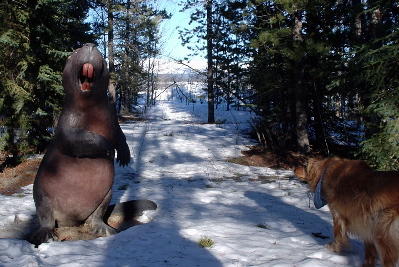ROUS and Another Large Beast

In the movie, of course, the rodents-of-unusual-size were rat-like. Here in the Yukon, they were beaverish, and I've got the photo* to prove it. My dog, as you can see, doesn't like them very much. It could be those teeth-of-unusual size that scare her, or it could be the booming hollow metalic sound the creature makes when accidently thumped.
Speaking of giant beaver teeth, I have it on good authority that
In Minnesota, workers excavating for a road found an almost complete giant beaver skeleton. Well, he wasn't quite giant yet, since he would have weighed only 250 lbs. or so, and as everyone knows, grownup giant beavers weigh closer to 500 lbs.
Students from Minnesota petitioned the state government to name the giant beaver, more correctly known as Castoroides ohioensis, as the state fossil. Fortunately, older and wiser heads prevailed, and the petition was refused, because, among other things, the super-sized version of the beaver was already named after the state of Ohio. The students countered, without success, that some states had the regular-sized beaver (Castor canadensis) as their state animal, and that animal, after all, was named for a whole 'nuther country.
By now, I suppose you're wondering why the giant beaver became extinct. That's a good question. Probably part of it is that they just weren't equipped for a fight and they weren't equipped for hiding, either. Scientists blame global warming, too, but we all know they tend to use that excuse for everything bad that happens. Native legends blame the Hobomuck, a giant spirit**, who hit the giant beaver with a stick and killed it, and ever since, there have been no giant beavers swimming the ponds of the earth. I'm guessing that was a wasted effort, because if there was only one, they were on their way out, anyway.
Now that we've come to the point of extinction of the giant beaver, it's probably time to move on to the other large beast promised in the title. I've mentioned him (or is it her?) here before, and he/she's been spotted in Teslin again, this time by at least nine people at once. Intriguingly, the big guy also left a big footprint (or was a bigfoot print?) and a tuft of hair behind.
As I write this, scientists are busily studying that hair to determine what sort of creature it came from. One biologist is 99.9% sure from his examination that it is hair from a bison. The DNA test results are due out today or tomorrow. I'm betting it's 100% bison.
And if it is, that'll prove nothing at all. If sasquatches exist, it seems quite clear that they don't much want to be found. Who's to say every sasquatch doesn't carry a clump of bison hair in the pocket of his ape suit so that if he's ever unfortunate enough to see nine people staring at him he can leave a bit-o-bison behind to throw them off track?
*No, we don't have snow year round in the Yukon, despite what some might think. This photo was taken last winter.
**Yes, I know you're wondering too: How, pray-tell, can something immaterial have size?
Speaking of giant beaver teeth, I have it on good authority that
[u]nlike modern beavers with their short smooth-surfaced cutting teeth (incisors), giant beavers had cutting teeth up to 15 cm long with prominently-ridged outer surfaces. Perhaps these strong enamel ridges would have acted as girders to support such long teeth. Although experts on ancient life (paleontologists) do not agree on the function of the cutting teeth, it seems that they could have acted as both wood cutters and gougers.Girders and cutters and gougers? No wonder my dog's scared of them. But those of us who can read know that there's no reason to be scared as long as you're not a vegetable. Some scientists believe that even trees were probably more than those beavers could chew and they were content to eat "coarse swamp vegetation such as roots and cattails."
In Minnesota, workers excavating for a road found an almost complete giant beaver skeleton. Well, he wasn't quite giant yet, since he would have weighed only 250 lbs. or so, and as everyone knows, grownup giant beavers weigh closer to 500 lbs.
Students from Minnesota petitioned the state government to name the giant beaver, more correctly known as Castoroides ohioensis, as the state fossil. Fortunately, older and wiser heads prevailed, and the petition was refused, because, among other things, the super-sized version of the beaver was already named after the state of Ohio. The students countered, without success, that some states had the regular-sized beaver (Castor canadensis) as their state animal, and that animal, after all, was named for a whole 'nuther country.
By now, I suppose you're wondering why the giant beaver became extinct. That's a good question. Probably part of it is that they just weren't equipped for a fight and they weren't equipped for hiding, either. Scientists blame global warming, too, but we all know they tend to use that excuse for everything bad that happens. Native legends blame the Hobomuck, a giant spirit**, who hit the giant beaver with a stick and killed it, and ever since, there have been no giant beavers swimming the ponds of the earth. I'm guessing that was a wasted effort, because if there was only one, they were on their way out, anyway.
Now that we've come to the point of extinction of the giant beaver, it's probably time to move on to the other large beast promised in the title. I've mentioned him (or is it her?) here before, and he/she's been spotted in Teslin again, this time by at least nine people at once. Intriguingly, the big guy also left a big footprint (or was a bigfoot print?) and a tuft of hair behind.
As I write this, scientists are busily studying that hair to determine what sort of creature it came from. One biologist is 99.9% sure from his examination that it is hair from a bison. The DNA test results are due out today or tomorrow. I'm betting it's 100% bison.
And if it is, that'll prove nothing at all. If sasquatches exist, it seems quite clear that they don't much want to be found. Who's to say every sasquatch doesn't carry a clump of bison hair in the pocket of his ape suit so that if he's ever unfortunate enough to see nine people staring at him he can leave a bit-o-bison behind to throw them off track?
*No, we don't have snow year round in the Yukon, despite what some might think. This photo was taken last winter.
**Yes, I know you're wondering too: How, pray-tell, can something immaterial have size?
Labels: Yukon life








<< Home